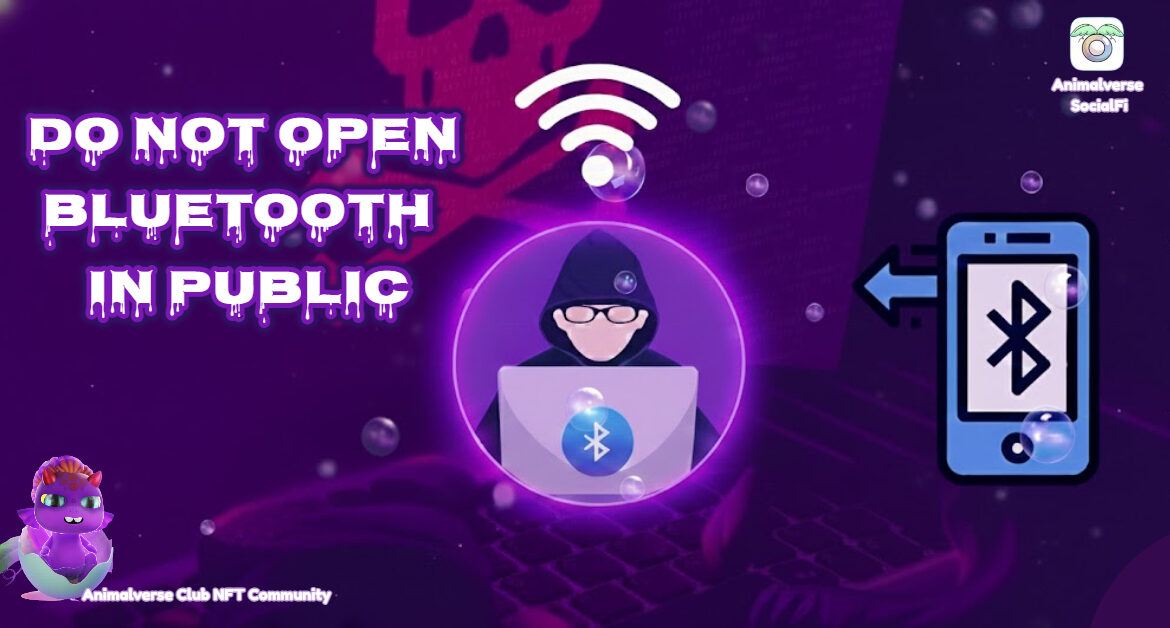Wireless connectivity technology like Bluetooth has become something that almost everyone uses regularly, whether it’s listening to music through wireless headphones, connecting smartwatches, sending files, connecting wireless keyboards/mouses, or even locating various devices in everyday life. But at the same time, all this convenience comes with important questions that many people wonder about:
Table of Contents

“Is leaving Bluetooth on in public really dangerous?”
“And has anyone ever had their crypto stolen because they had Bluetooth on?”
Based on cybersecurity data, new generations of Bluetooth technology, past hacker attacks, and the technical reasons why Bluetooth is almost a direct lead to crypto theft, along with best practices for maximum security.
What is Bluetooth and how does it work?
Bluetooth is a short-range wireless communication technology designed for close-range connections, such as devices within 10 meters, and focuses on power saving rather than data transmission speed, unlike Wi-Fi, which has a longer range and higher speed.
The main features of Bluetooth include:
- Close connection distance
Typically it is 1–10 meters, although High-Power models can reach up to 100 meters, but in real-world use it is often less. - 2.4 GHz frequency
It uses the same frequency as Wi-Fi, which can cause interference, but Bluetooth uses “frequency hopping” to reduce this risk. - Pairing before use
Connections between devices must be “paired” to exchange encryption keys before they can be used, giving hackers a chance to intervene. - Random MAC Address in new version
Most newer devices, such as iPhones, Samsungs, and Androids, use random MAC addresses, making it difficult to track their location via Bluetooth.
With improved security features over time, Bluetooth has become more protected, but there are still vulnerabilities that could lead to hacking or access to your assets. This article will reveal what they are.

The dangers of using Bluetooth in public places
While Bluetooth has many security measures in place, leaving it exposed in public places poses significant risks in this era of accessibility and ease of use, making it a common practice for malicious actors to exploit these vulnerabilities, which can be categorized into several levels:
Device Discovery
Even though newer phones prevent “Discoverable mode” from being enabled all the time, Bluetooth can still be scanned for signals. A hacker with a scanning device can:
- See device names like “iPhone 17”, “Galaxy S23”
- Analyze the types of equipment used
- See random MAC addresses (and can also be used to analyze multiple patterns)
While seeing a Bluetooth signal doesn’t immediately give hackers control over a phone, it can be the starting point for many types of attacks.
Operating system-level Bluetooth vulnerability
There are Bluetooth vulnerabilities that have occurred such as:
BlueBorne Attack It is one of the most serious vulnerabilities ever discovered.
- Take control of your mobile phone immediately
- Remotely install malware
- No need to pair first
This is a vulnerability that can give hackers instant access to your data or crypto assets.
What is BlueBorne attack?
BlueBorne is a security vulnerability that affects several operating systems, including Android, older iOS, Windows, and Linux. It allows hackers to attack devices over Bluetooth without pairing (No Pairing Required) and without requiring any authorization from victims.

BLE (Bluetooth Low Energy) vulnerability
BLE used with some smartwatches, headphones, and IoT devices poses risks, such as:
- Data is not encrypted during connection
- Use a default PIN such as “0000” or “1234”.
- Force users to pair without setting security settings
Forced Pairing / Fake Pairing Attack
Hackers can send “fake pairing requests” to devices that have Bluetooth turned on, causing:
- A popup will appear asking you to confirm.
- If the victim “accidentally agrees,” it may open a loophole to access some of the data.
Nowadays, new mobile phones have many restrictions, so the risk is much less than in the past.
Bluetooth Sniffing
Directly intercepting Bluetooth data is very difficult because it is encrypted. However, older or very cheap devices with poor encryption from IoT devices lack encryption standards, which can lead to some data being intercepted. However, this type of intercepting cannot steal crypto or access digital wallets, which will be explained in the next section.

Has there been an incident where hackers “stole crypto because Bluetooth was turned on?”
There has never been a global incident where someone has had their crypto stolen simply because Bluetooth was turned on in a public place, as the global adoption of crypto is still very low and it is impossible to know who is using it. However, one should not be complacent.
There are no reports in the security or technology media.
Bluetooth attack or Wi-Fi attack, which is more dangerous?
Wi-Fi poses a much higher risk than Bluetooth, including:
- Evil Twin WiFi
- Rogue AP
- Wi-Fi phishing portal
However, Bluetooth doesn’t work like Wi-Fi.
How to stay safe when using Bluetooth?
While Bluetooth can be dangerous enough to steal crypto, there are some basic precautions you should take to protect yourself:
- Always update your operating system.
Because patches for critical vulnerabilities come with updates. - Turn off Bluetooth when not necessary.
Reduce the chance of being scanned or forced pairing - Do not accept pairing requests from unknown devices.
- Avoid using very cheap headphones or Bluetooth devices.
Many models do not have good encryption and are widely available. - Use a crypto wallet with multiple locking systems.
PIN
Face ID / Fingerprint
Unguessable passwords
Multi-sign for transection - Use a hardware wallet for large amounts of coins.
This is the best way for the most secure in this moment.

Reference: Verster Community
https://animalverse.social/bluetooth-in-public-places-can-crypto-hacking/
Bluetooth in public places can lead to crypto hacking Summary
Leaving Bluetooth enabled in public places can be vulnerable to the BlueBorne attack on older or outdated devices. This vulnerability allows hackers to gain access to your phone without pairing or requiring authorization. Once compromised, attackers can take control of your device, install malware, spy on personal data, and extract sensitive files. They can also indirectly steal information related to your financial accounts, banking apps, or cryptocurrency wallets, such as through keyloggers or extracting stored seed phrases. While crypto can’t be directly extracted via Bluetooth, taking control of your phone significantly increases the risk. Therefore, it’s important to keep your device up-to-date and disable Bluetooth when not in use for added security.
Join our gang by purchasing the Animalverse Club NFT, which is the key to accessing a ton of benefits.
Animalverse SoicialFi is a web3 social media platform de signed to connect users around the world without the influence of algorithms, promoting equal access to information. The platform aims to create a decentralized environment where users can freely share and consume content and send crypto, which is fully consistent with the principles of blockchain technology. Let’s be a part of AVC ecosystem Community BlackMarketplace Groups Games Jobs Financial Blog News
FAQ: Dangers of Bluetooth and BlueBorne Attack
1. What is a BlueBorne attack?
BlueBorne is a vulnerability that allows hackers to compromise a mobile phone or other Bluetooth-enabled device without first pairing it or requiring the victim to authorize it.
2. How close do hackers have to be to attack?
Just stay within the Bluetooth signal range of about 5–10 meters and you can start attacking.
3. How do hackers hack mobile phones?
Exploiting Bluetooth vulnerabilities to execute malicious code and control devices as if they were the owner.
4. Can leaving Bluetooth on be hacked?
Yes, if the device has not been updated with the patch and Bluetooth is always on.
5. What information is at risk of being stolen?
Passwords, crypto wallet private keys, images, files, messages, and login information.
6. Can BlueBorne attacks steal crypto?
If a hacker successfully compromises a device, they can instantly access the wallet app, steal the seed phrase or password.
7. Which devices are at risk?
Android, iOS (older, non-updated versions), Windows, Linux, Smart TV, Smartwatch, and IoT mobile phones.
8. How to prevent it?
Turn off Bluetooth when not in use, keep your system updated regularly, and use apps and files from trusted sources.
9. How do you know if you’re being attacked?
Most are difficult to detect. Devices may start to freeze, overheat, or start working without being triggered.
10. Does using Bluetooth headphones increase your risk?
If your device is up to date, the chances of being attacked are very low, but you should still turn off Bluetooth when not in use.






